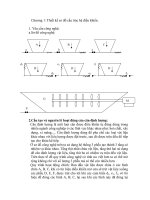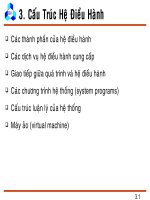Operating System Structures Cấu trúc Hệ điều hành
Bạn đang xem bản rút gọn của tài liệu. Xem và tải ngay bản đầy đủ của tài liệu tại đây (148.55 KB, 2 trang )
Operating
System
Structures
Cấu trúc
Hệ điều hành
Practice Exercises
Bài tập thực hành
2.1 What is the purpose of system calls?
Mục đích của system call là gì?
2.2 What are the five major activities of an operating system in regard to process
management?
Năm hoạt động chính của hệ điều hành liên quan đến quản lý tiến trình là gì?
2.3 What are the three major activities of an operating system in regard to memory
management?
Ba hoạt động chính của hệ điều hành liên quan đến quản lý bộ nhớ là gì?
2.4 What are the three major activities of an operating system in regard to
secondary-storage management?
Ba hoạt động chính của hệ điều hành liên quan đến quản lý bộ nhớ phụ là gì?
2.5 What is the purpose of the command interpreter? Why is it usually separate from
the kernel?
Mục đích của bộ dịch lệnh là gì? Tại sao nó thường được tách từ kernel?
2.6 What system calls have to be executed by a command interpreter or shell in order to
start a new process?
System call nào phải được thực thi bởi bộ dịch lệnh hay shell để mà bắt đầu một
tiến trình mới?
2.7 What is the purpose of system programs?
Mục đích của chương trình hệ thống là gì?
2.8 What is the main advantage of the layered approach to system design? What are the
disadvantages of using the layered approach?
Lợi ích chính của phương pháp phân tầng là gì? Những bất lợi của việc sử dụng
phương pháp phân tầng là gì?
2.9 List five services provided by an operating system. Explain how each provides
convenience to the users. Explain also in which cases it would be impossible for
user-level programs to provide these services.
Liệt kê năm dịch vụ của hệ điều hành. Giải thích sự tiện lợi cho người dùng ứng với
từng dịch vụ đó. Mở rộng thêm trong trường hợp nào thì không thể cung cấp những
dịch vụ đó cho chương trình cấp người dùng.
2.10 What is the purpose of system calls?
Mục đích của system call là gì?
2.11 What are the main advantages of the microkernel approach to system design?
Lợi ích chính của phương pháp microkernel (vi nhân) là gì?
2.12 Why do some systems store the operating system in firmware, and others on disk?
Tại sao một số hệ thống lưu trữ hệ điều hành trên firmware, còn một số khác thì lưu
trên đĩa?
2.13 How could a system be designed to allow a choice of operating systems to boot
from? What would the bootstrap program need to do?
Hệ thống được thiết kế thế nào để cho phép có sự chọn lựa hệ điều hành từ lúc khởi
động? Chương trình khởi động cần phải làm điều gì?









